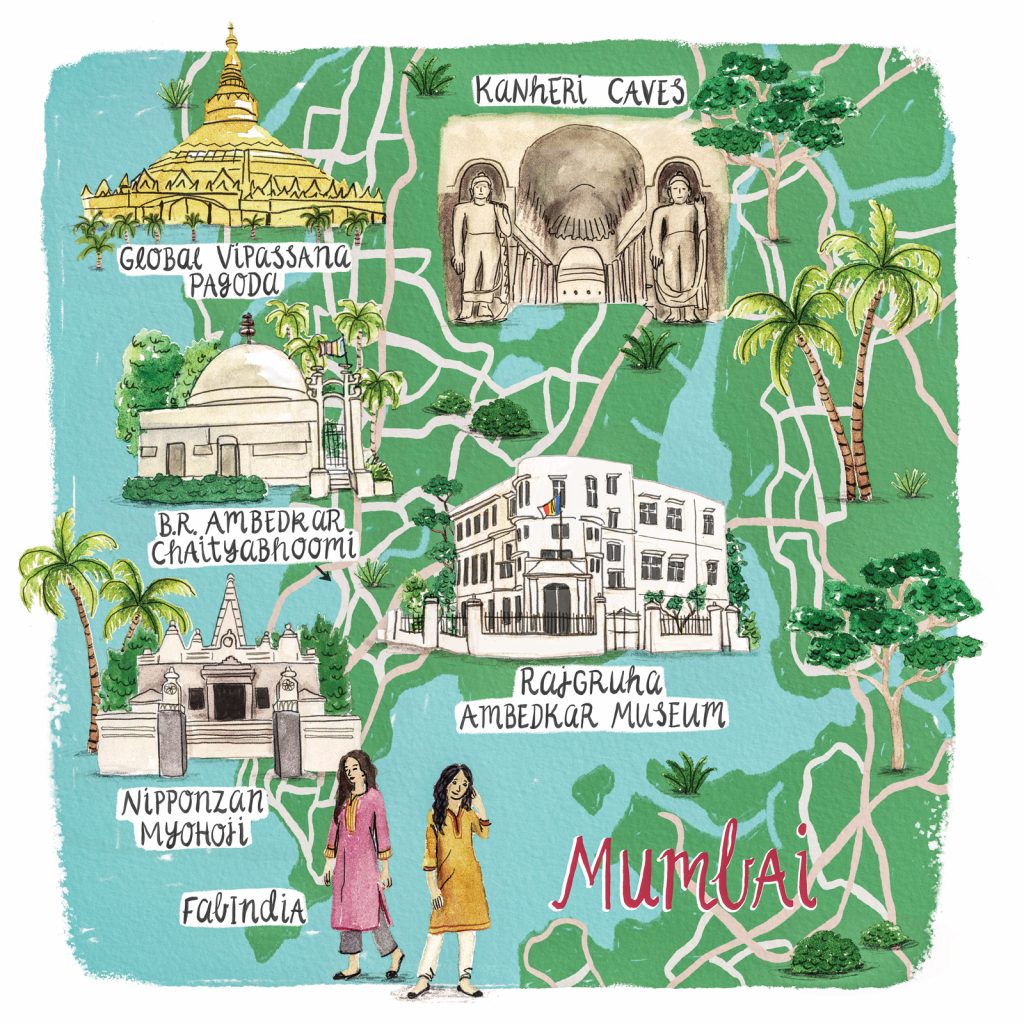The greater Mumbai area, home to more than 22 million people, is a world away from remote and serene Buddhist monasteries in the Himalayas. But Buddhism is alive in India’s most densely populated city and financial and film capital. Mumbai has the largest urban Buddhist population in India and makes up nearly 80 percent of the country’s total Buddhist population.
Most of the city’s Buddhists are followers of Dr. Bhimrao Ramji Ambedkar (1891–1956), who led a movement that converted hundreds of thousands of Dalit (“untouchable”) Hindus to Buddhism to escape the horrors and discrimination of the caste system. Today, Ambedkar continues to be revered, and his image can be found just about everywhere you turn, including in smaller temples, which include statues of his likeness in addition to the Buddha’s.
1| Fabindia
Traditional clothing isn’t a prerequisite for visiting Indian houses of worship, but modesty is. For sixty years, Fabindia has worked with rural artisans to sell clothes, jewelry, furniture, and more. Kurtas, long-sleeve shirts, and loose pants provide good sun coverage and a cooler option than jeans or leggings, and you can find every color and pattern imaginable. Shorts are not temple-appropriate; women might consider adding a scarf, called a dupatta, or stole, depending on the length, for covering arms or the head if required. Fabindia has hundreds of stores in India, with several in Mumbai; we recommend the Fort location, close to the famous Gateway of India and Crawford Market.
Jeroo Building, B Bharucha Road, Kala Ghoda, Fort
fabindia.com
2| Kanheri Caves
If you have only one full day for Buddhist sightseeing in Mumbai, spend it at this ancient complex. The 109 Buddhist caves carved into a basalt rock hill were constructed as early as the 3rd century BCE, and were in use as a center for Buddhist study and worship up to the 11th century. The massive Buddhas in themselves are magnificent; Kanheri is known for a unique eleven-headed Avalokiteshvara. The caves are situated within Sanjay Gandhi National Park, which offers additional sites and attractions, including hiking, a safari, Jain temple, waterfall, and lakes. The caves are about seven kilometers inside the park, and uphill; cars can be hired once inside the main park’s entrance. You can also hike up; just be aware of the wildlife threats, including leopards. Guard your snacks from resident monkeys, they are quick.
Sanjay Gandhi National Park
3| B.R. Ambedkar Chaityabhoomi
Chaityabhoomi was the site of Ambedkar’s cremation in 1956, and his death anniversary, or Mahaparinirvan Din, brings millions of pilgrims every December 6. The main hall includes a statue of the Buddha; sitting below him is an Ambedkar bust adorned with flower garlands and illuminated by candles, and a monk nearby to offer blessings. The main entrance gate and pillar are replicas of the Sanchi Gate and Ashoka Pillar, and stalls leading to the temple sell Ambedkar literature, flowers for offerings, and a wide variety of Buddha and Ambedkar tchotchkes. Chaityabhoomi is on the waterfront, steps away from Dadar Chowpatty (beach) and Shivaji Park.
2RGM+2HJ, D Mandir Road, Dadar West, Dadar
4| Global Vipassana Pagoda
The Global Vipassana Pagoda, on Mumbai’s northern outskirts, was a project S. N. Goenka (1924–2013) worked to complete toward the end of his life that honored his teacher, Sayagyi U Ba Khin, as well as educating visitors about the Vipassana tradition. The gold-painted pagoda stands at 325 feet tall and contains Buddha relics. The complex includes a pillar-less dome that can accommodate 8,000 people (but only those who have completed a Goenka ten-day course can meditate there). A ten-minute anapanasati (mindfulness of breathing) course is offered continuously from 10 a.m. to 6:30 p.m., and all visitors aged 10 and up can participate. Getting there is a trek that includes a ferry ride and magnificent views; take advantage of the vegetarian food options onsite.
Global Vipassana Pagoda Road, Gorai Village, West Borivali
globalpagoda.org
5| Nipponzan Myohoji
This Nichiren Buddhist temple has the distinction of being Mumbai’s oldest—and possibly only—Japanese Buddhist place of worship. The temple’s founder, Nichidatsu Fujii (1885–1985), traveled to India in the ’30s to fulfill Nichiren’s prophecy to bring the Lotus Sutra to India. Today, visitors can chant the daimoku in the temple, which includes a large marble Buddha and vibrant paintings depicting scenes from the Buddha’s life. Resident monk Bhikshu T. Morita continues the vision of the order’s founder by working to construct a new peace pagoda and running a nonsectarian school for local children.
2R28+79P, Dr. Annie Besant Road, opp. Poddar Hospital, B Wing, Worli
nipponzanmyohojimumbai.com
6| Rajgruha (Ambedkar Museum)
Ambedkar’s former mansion is an opportunity to pay homage and to learn more about his life. Ambedkar is said to have constructed the residence to house his personal library, which, at 50,000 books, was one of the largest in the world at the time (a portion of his collection now lives at Mumbai’s Siddharth College Library). Rajgruha is an important site to many Ambedkarite Buddhists, and the ground-floor museum contains other significant personal items from his life.
Dadar East, 129, Khare Ghat Marg, Hindu Colony
Thank you for subscribing to Tricycle! As a nonprofit, we depend on readers like you to keep Buddhist teachings and practices widely available.
